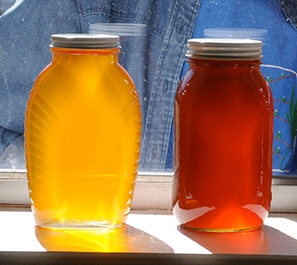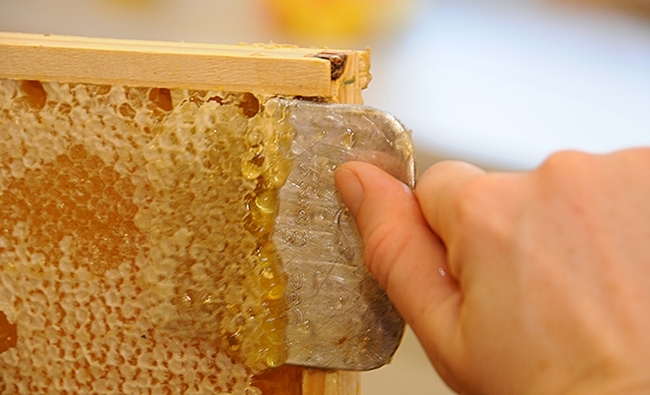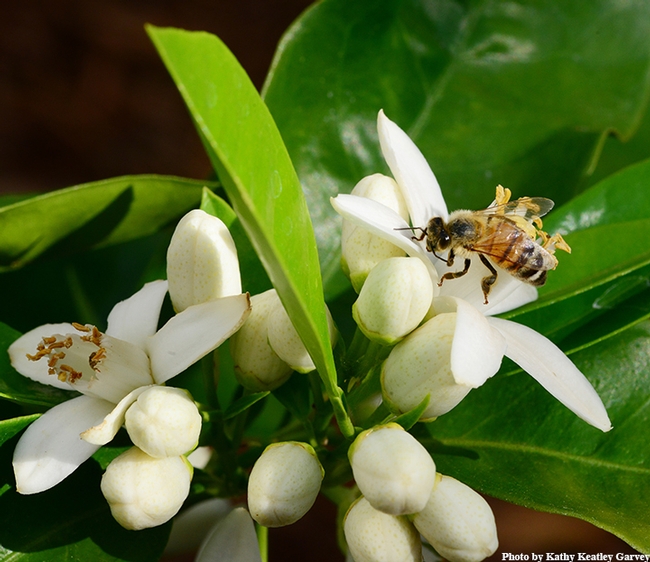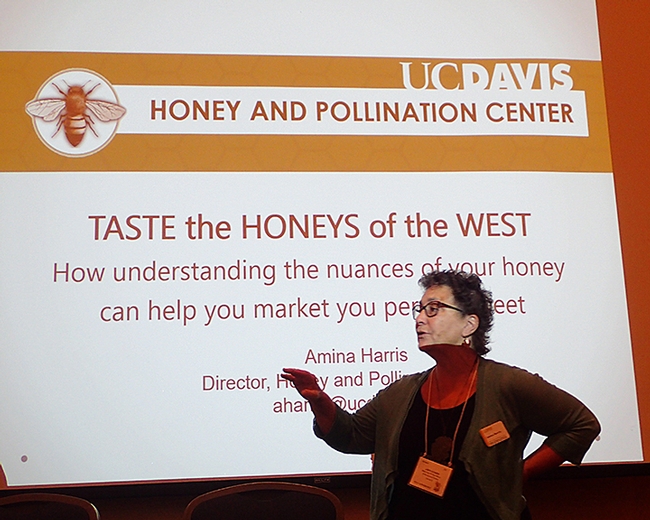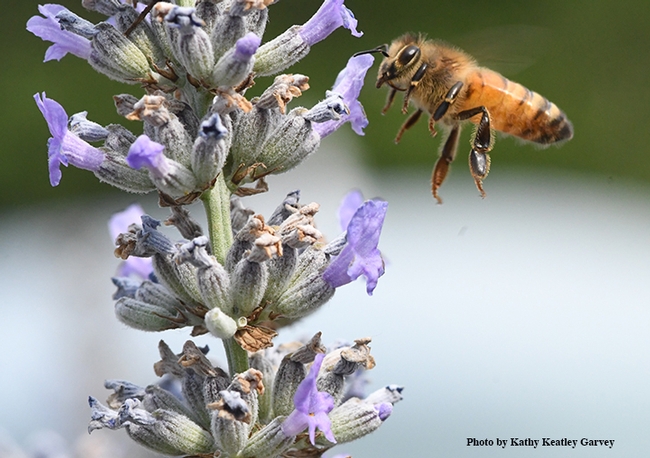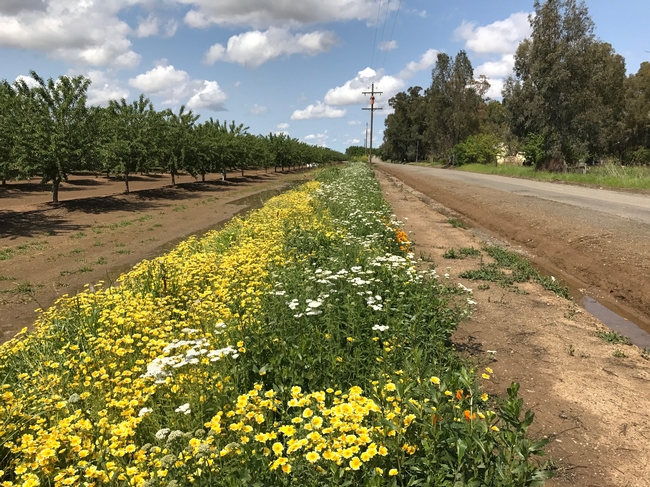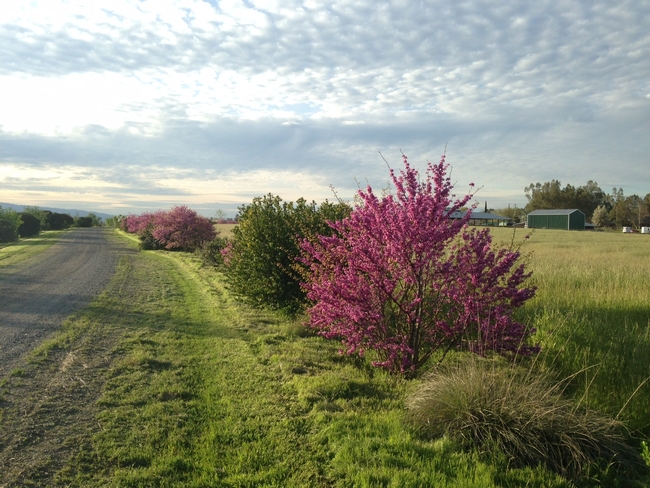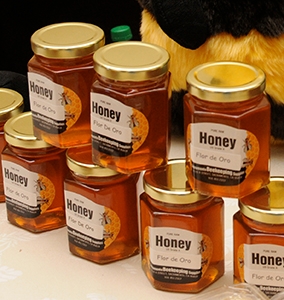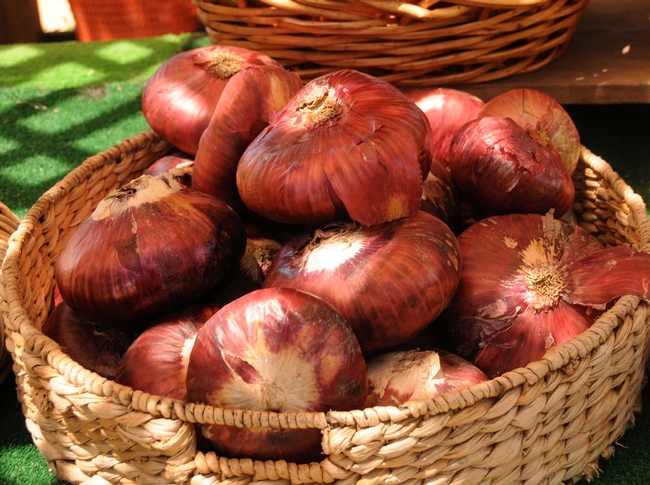Posts Tagged: pollination
A honey of an educational odyssey -- and you're invited
Show me the honey!
You've probably tasted wine in California's acclaimed Wine Country, but have you ever tasted honey in the nation's rapidly growing “Honey Country”—the University of California, Davis?
Now you can.
The UC Davis Honey and Pollination Center is hosting a Honey Sensory Experience next month so you can learn all about honey, taste honey varietals from all over the world, and hear what researchers are doing.
The Honey Sensory Experience is scheduled for Nov. 10-11 in the Robert Mondavi Institute for Wine and Food Science's Sensory Building on Old Davis Road. The course is for beekeepers, bakers, mead makers, honey lovers, packers, importers, professional buyers, honey producers, and "anyone who wants to gain expertise in the aroma of honey analysis," said Amina Harris, director of the UC Davis Honey and Pollination Center, which is closely affiliated with the Robert Mondavi Institute for Wine and Food Science and the UC Davis Department of Entomology and Nematology, part of the UC Agriculture and Natural Resources (UC ANR). "Over two days, expert teachers will guide participants through a unique tasting and educational odyssey."
The event revolves around a first-of-its-kind study in the United States. or the past nine months, the center has been working with a team of sensory experts and trained tasters in the sensory lab in the UC Davis Department of Food Science and Technology. The panel analyzed the flavor, aroma, color, pollen and nutrition of three varietal honeys with samples produced across the nation.
The center's goal is to create a description of each varietal honey's unique characteristics.
“We have about 300 varietal honeys here in the United States,” Harris pointed out. “Many aren't produced each year. And some years actually have a better crop than others. Our center's goal is to help consumers understand what each varietal honey should really taste like.”
Well-known varietals include orange blossom and clover honeys, although these are rarely pure varietals, Harris said.
“According to current honey labeling laws, the varietal listed on the label need only be the predominant floral source. Simply, a blended honey of 23 percent alfalfa, 25 percent wildflower and 25 percent cotton with 27 percent orange blossom can be labeled ‘Orange Blossom Honey.' Swap out the orange blossom for clover and you have a new varietal.”
Harris said the center is "ready to share our experiences. Together we will spend two full days tasting varietal honeys from the world over and investigating the bees' handiwork. It all starts with nectar.”
The Honey and Pollination Center, at the forefront of honey sensory research, developed the first-ever Honey Flavor and Aroma Wheel. The wheel has been featured on National Public Radio, at the Smithsonian, and at tastings and specialty food conferences across the country.
With interest in honey is on the rise, consumers are actively looking for intriguing varietals, said Harris, who has tallied 35 years of experience in the world of varietal honeys. “The Honey Sensory Experience is the perfect opportunity for consumers looking to better-understand how honey is developed—from the moment the honey bee collects the nectar, until the honey is on the supermarket shelf."
"The two-day program “will bring together a group of exceptional presenters to explain all the nuances from nutrition to flavor to cooking."
In addition to Harris, the presenters will include Orietta Gianjorio, member of the Italian Register of Experts in the Sensory Analysis of Honey; Hanne Sivertsen, sensory researcher, UC Davis Department of Food Science and Technology; Amy Myrdal Miller, certified nutritionist and owner of Farmer's Daughter Consulting, Sacramento; Joyce Schlacter, certified quality control specialist and director of food safety and quality, Smitty Honey, Iowa; chef Mani Niall, owner of Sweet Bar Bakery, Oakland, Calif. and Extension apiculturist Elina Lastro Niño, based in the UC Davis Department of Entomology and Nematology.
Niall, known as “Baker to the Stars,” served as a chef to Michael Jackson and a chef for the National Honey Board in the 1990s. He is the author of the book, Covered in Honey: The Amazing Flavors of Varietal Honey.
Miller, a UC Davis graduate, is an “amazing nutritionist,” Harris said. She is a farmer's daughter, a highly regarded public speaker, published author, and founder and president of Farmer's Daughter Consulting, a privately-held agriculture, food, and culinary communications firm.
The Honey and Pollination Center is sponsored by the Robert Mondavi Institute for Wine and Food Science and the UC Davis Department of Entomology and Nematology, part of the UC Agriculture and Natural Resources (UC ANR).
The course, which includes breakfast and lunch each day, is $625. To access the agenda and to register, see http://honey.ucdavis.edu/events/honey-sensory-experience-an-introduction.
Super blooms in the Central Valley: Why it’s not just about the color
Have you seen the blaze of super blooms popping up alongside orchards and field crops in our rich agricultural Central Valley? The corridors of poppies, tidy tips, yarrow, baby blue eyes, and redbud planted by farmers, dazzle us with color, but they serve a purpose, too.
The flowers provide nectar and pollen for the pollinators, including honey bees, bumble bees and carpenter bees. Look beyond the buzz, and you'll see other beneficial insects, such as lady beetles (ladybugs) and their larvae devouring aphids, and tiny parasitoid wasps preying on stinkbugs and armyworms. They're (unpaid) pest control agents at work.
Farmers are taking notice. Knowing that most beneficial insects rely on floral resources to survive and reproduce, they're bordering their field crops with strips of flowering plants. In addition to gaining pollination and pest control services, they're gaining financial benefits. University of California researchers documented that pest control and pollination benefits will help pay the cost of a 1,000-foot-long-flowering hedge planting within 7 to 16 years. Their research, Pest Control and Pollination Cost-Benefit Analysis of Hedgerow Restoration in a Simplified Agricultural Landscape, was published last year in the Journal of Economic Entomology.
Other benefits of field edge habitat plantings can include weed exclusion, air quality improvement, erosion reduction, wind protection, shade, and wildlife habitat.
What plants are best to attract beneficial insects to farms and gardens? The UC Statewide Integrated Pest Management Program (UC IPM) has just published a list of insectary plants on its website. The list includes native California perennial flowering shrubs and wildflowers suited for field-edge plantings.
UC IPM defines insectary plants as “those grown to attract, feed, and shelter insect parasites (parasitoids) and predators to enhance biological pest control. Insectary plants provide nectar and pollen for adult natural enemies to consume. Even if pests are abundant, certain natural enemies may be less abundant, shorter-lived, or produce fewer offspring unless nectar and pollen resources are available. Insectary plants can also host alternate prey that will feed the natural enemies and keep them abundant locally.”
Are you concerned about rodents and food safety issues from hedgerows plantings? Not to worry. A recent study by UC Agriculture and Natural Resources (UC ANR) researchers found minimal adverse influence on larger agricultural landscapes. A bonus: Migratory songbirds, like goldfinches, often seek out the seeds from the flowering plants in the hedgerows and offer their own display of color. What about weeds? Yes, they can be problematic. Be sure they're well-controlled before planting wildflowers; think soil solarization and herbicides.
Another UC ANR-associated study, Determinants of Field Edge Habitat Restoration on Farms in California's Sacramento Valley, published this year in the Journal of Environmental Management, found that landowners and farmers familiar with the benefits were more likely to adopt these small-scale habitat restoration plantings on their farms. Also important is technical support from agencies such as the USDA, UC Cooperative Extension Service, and the Xerces Society for Invertebrate Conservation, and the sharing of information from farmer-to-farmer and neighbor-to-neighbor.
Something else we can all do: Share your photos of field-edge habitat plantings and your observations on social media. They tell an important story and can inspire landowners to diversify farmlands. This will help drive home the point that providing flowers for beneficial insects, including bees and natural enemies, will build resilience in our farming systems. Natural pollination and pest control services help counter the disastrous effects of colony collapse disorder and other honey bee maladies, and pesticide resistance.
And it's a counter-punch of color.
How wildflower plantings on farms benefit bees and crop pollination
Bloom where you're planted.
That old adage takes on more meaning when you plant wildflower strips on your farm. Wildflowers add resilience to our farming systems by providing bees with habitat and food - pollen and nectar. And they're not just for honey bees. Many native bees, such as bumble bees and blue orchard bees, are important crop pollinators. Currently about a third of our crops benefit from bee pollination. This includes vegetables, fruit and nuts, as well as crops grown for seed production, including sunflower, melon, and carrot.
Farmers primarily rely on honey bees for crop pollination; generally two colonies per acre are needed. Honey bees are efficient pollinators, but with colony collapse and increasing colony losses, we must diversify our farming systems so we don't rely solely on honey bees.
Some important native bee crop pollinators include bumble bees, sunflower bees, squash bees, mason bees (blue orchard bees, which pollinate almonds, are mason bees) and leafcutter bees.
The benefits of native bees? Generally they forage on flowers earlier in the day than honey bees do, they tolerate more wind and cooler temperatures and often they're more efficient at gathering and moving pollen from one flower to another. Native bees also prompt honey bees to disperse more, resulting in more pollinator efficiency. All this is important for good pollination and crop production, especially for crops like almonds that bloom in late winter when the weather is more unpredictable.
Many native bees, including squash bees, nest in the soil, generally excavating chambers about 12 inches deep, where they pack cells with pollen for their young. Bumble bees often occupy vacated rodent holes. Leafcutter bees nest in woody cavities, often taking advantage of old beetle galleries. Discing and land clearing removes their nesting sites and potential food sources, but if you add wildflower plantings and hedgerows of flowering shrubs on your farm, that brings them back. Farms with strips of flowers along field edges have higher numbers of native bees than those that do not. Honey bees also benefit from better nutrition from flowers, strengthening their resiliency to pests, diseases, and pesticides.
A recent study, Pest Control and Pollination Cost–Benefit Analysis of Hedgerow Restoration in a Simplified Agricultural Landscape, published by UC Agriculture and Natural Resources (UC ANR) and UC Berkeley, describes the economic value of these plantings. Generally, a $4,000 investment to plant a 1,000-foot hedgerow of native California plants, takes about seven years to pay off from enhanced pest control and pollination services from natural enemies and bees (where honey bees are limiting). If cost-share funding is available from the USDA, this will reduce the investment cost for the restoration and time on returns.
Although habitat plantings are definitely beneficial, some farmers have expressed concern that these plantings will bring in more pests, including rodents, birds and weeds. However, current UC ANR studies show strips of flowers on field edges export beneficial insects into adjacent crops for enhanced pest control. The wildflower strips are too small to support large numbers of rodents or flocking birds that can damage crops (with the possible exception of ground squirrels and cottontail rabbits), and weeds requiring management are present regardless of field edge habitat.
Water? Although it's hot and dry out right now, many wildflowers do not need summer water. This includes Bolander's sunflower (great for songbirds like goldfinches, but the seeds should not be included in row crop mixes as they will cross-pollinate with our hybrid sunflower seeds), milkweed (great for monarch butterflies), vinegarweed, tarweed, gumplant, turkey mullein (doves love these seeds), and summer lupine. Bees, including natives and honey bees, thrive on these hardy flowers, especially now that the growing season is ending, and few crops are blooming.
Look for more information on wildflower and hedgerow plantings on the Hedgerow Hub website, , the Xerces Society website, and UC Davis fact sheet Habitat for bees and beneficials.
Networking is important too. A recent UC ANR survey showed that networking among growers, landowners, and conservation agencies is crucial in the adoption and implementation of new ideas, such as wildflower plantings.
Bottom line: Wildflower strips can ensure a healthy, sustainable food supply for crops that rely on bee pollination. “Bloom where you're planted” equals “Reap what you sow.”
How to make something sweet even sweeter
It's more than that if you're a beekeeper. It's your pride and joy.
Whether beekeeping is your livelihood, your leisure activity, or something you do to help the declining bee population, that byproduct of your bees--honey--can also be an opportunity for bragging rights.
Entries are now being accepted for the nationwide honey competition sponsored by Good Food Awards.
If you're one of the nation's beekeepers, there's still time to enter your honey, says contest coordinator Amina Harris, director of the UC Davis Honey and Pollination Center.
The deadline to do so is Sunday, July 31. The four subcategories are Liquid and Naturally Crystallized, Creamed, Comb, and Infused Honey.
The contest is divided into five regions--East, South, North, Central and West--with seven or more states assigned to one region, Harris says.
- West: California, New Mexico, Arizona, Hawaii, Nevada, Hawaii and Alaska.
- North: Oregon, Washington, Idaho, Montana, Wyoming, North and South Dakota and Minnesota
- Central: Colorado, Nebraska, Kansas, Missouri, Iowa, Illinois, Wisconsin, Michigan, Indiana, Ohio and Kentucky
- East: Maine, New Hampshire, Vermont, New York, Pennsylvania, Massachusetts, Connecticut, Rhode Island, New Jersey, Maryland and West Virginia
- South: Virginia, North and South Carolina, Tennessee, Georgia, Florida, Alabama, Mississippi, Arkansas, Oklahoma, Louisiana and Texas
"Finalists from each region are selected on a tasting day in September," Harris explains. "They are vetted according to criteria on this page. Winners are selected during the fall months and announced at the end of the year. The awards will be presented in mid-January."
Harris says there are more than 300 unique types of honey in the United States. The Good Food Awards will showcase honeys most distinctive in clarity and depth of flavor, produced by beekeepers practicing good animal husbandry and social responsibility. The honey can come from hives located in numerous places, from rooftops to fields to backyards.
Last year's top awards went to:
- Bee Girl, Bee Girl Honey, Oregon
- Bee Local, Bee Local Sauvie Honey, Oregon
- Bee Squared Apiaries, Rose Honey, Colorado
- Bees' Needs, Fabulous Fall, New York
- Bloom Honey, Orange Blossom, California
- Gold Star Honeybees, Gold Star Honey, Maine
- Hani Honey Company, Raw Creamed Wildflower Honey, Florida
- Mikolich Family Honey, Sage and Wild Buckwheat, California
- MtnHoney, Comb Honey Chunk, Georgia
- Posto Bello Apiaries, Honey, Maine
- Sequim Bee Farm, Honey, Washington
- Simmons Family Honey, Saw Palmetto Honey, Georgia
- Two Million Blooms, Raw Honey, Illinois
- UrbanBeeSF, Tree Blossom Honey Quince & Tree Blossom Honey Nopa, California
To enter the competition, access this page: http://www.goodfoodawards.org/honey/
The Honey and Pollination Center is affiliated with the Robert Mondavi Institute for Wine and Food Science and the UC Davis Department of Entomology and Nematology. For more information, email Harris at aharris@ucdavis.edu.
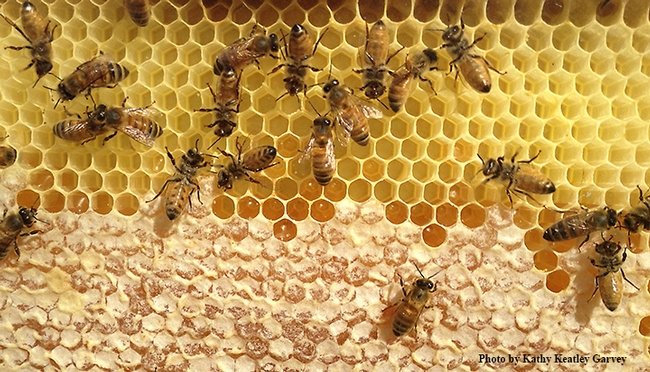
Honey bees in the process of making honey. This photo was taken through a bee observation hive. (Photo by Kathy Keatley Garvey)
Peel back the layers and see what the onion is all about
For crying out loud, who doesn't love an onion? Whether you enjoy them in burgers, broths, sandwiches or soups, or deep-fry them as onion rings or serve them with liver, they're to die for and to cry for.
The average American eats 21 pounds of onions per year. Indeed, our appetite for the fresh green as well as yellow, red, and white bulb onions is increasing in the United States, up 70 percent from several decades ago. A valued crop generating $1.2 billion a year, the onion currently ranks No. 2 in the vegetable industry, right behind the potato. Yellow onions account for nearly 90 percent of all onion consumption, followed by red and white varieties.
Onions, cultivated for more than 5,000 years, are one of the most versatile vegetables. They are found in every ethnic cuisine from breakfast to lunch to dinner and are rich in vitamin C and fiber. As Julia Child noted, “It's hard to imagine civilization without onions.”
With a thriving onion industry comes a “crying” need for onion seed planting stock; onions have to flower and set seed. California is a major worldwide supplier of onion seed, with growers producing about 3,000 acres of hybrid onion seed worth about $12 million, and generating an additional $40 million annually in subsequent retail sales. The major growing areas in our state are the Imperial Valley and Colusa County.
Seed companies from around the world contract with growers here in California to produce hybrid onion seed. The many different varieties include red, yellow and white bulbs, including types that are adapted to different day lengths from our northern to southern hemispheres. Growers plant onion bulbs or seedling transplants in late summer with distinct male (male fertile) and female (male sterile) onion lines in the same field. Generally, the field ratio is one row of males for every three female rows and they're tough to tell apart from a distance, but males produce pollen.
In Northern California, flowering occurs for a short four to five weeks the following May and June, with scapes from each bulb producing a white umbel with multiple florets. Growers rely on honey bees for cross pollination, that is moving the pollen from male to female rows. Each acre usually includes 10 to 12 hives. Native bees are also important for pollinating onion flowers, as are flies. No pollinators? No onion seed production.
Thankfully, there are few pests of onion seed, although the recent introduction of the iris yellow spot virus vectored by the onion thrips has resulted in increased insecticide use to control this potentially devastating pest and disease. Recent research by UC Cooperative Extension specialists in Yolo County and UC Davis, however, documented that more than three insecticide sprays applied pre-bloom per year can reduce honey bee visitation to flowers. Insecticides may also interfere with the ability of female flowers to receive pollen; that is, sprays applied near to bloom time can lead to overall lower pollen germination. As a result, growers are now careful to minimize insecticide use in onion seed production fields to ensure good pollination and yields.
Likewise, growers must carefully manage their irrigation water to ensure that the onion flowers produce good nectar rewards to maximize honey bee visitation. Honey bees are attracted to flowers with ample nectar production. Fields that are too wet or too dry show reduced floral nectar rewards and a decrease in honey bee visitation.
After cross-pollination occurs and seeds are set, growers knock down the male rows to remove them to facilitate harvesting of female lines and ensure purity of the seed. Once the female umbels dry down, they are harvested primarily by hand, placed on tarps to fully dry, and then the tiny black seeds from the florets are mechanically threshed with a combine, and cleaned and packaged for retail sales.
Although a small acreage crop in California, onion seed is an important specialty crop that significantly boosts our agricultural economy, as well as providing needed seed for farmers throughout the world.
But, before you can slice them, chop them or dice them, you have to grow them and our California growers do it best.
Additional information on onion seed production can be found at:
http://ceyolo.ucanr.edu/Custom_Program/Seed_Crop_Production/Onion_Seed_Production/
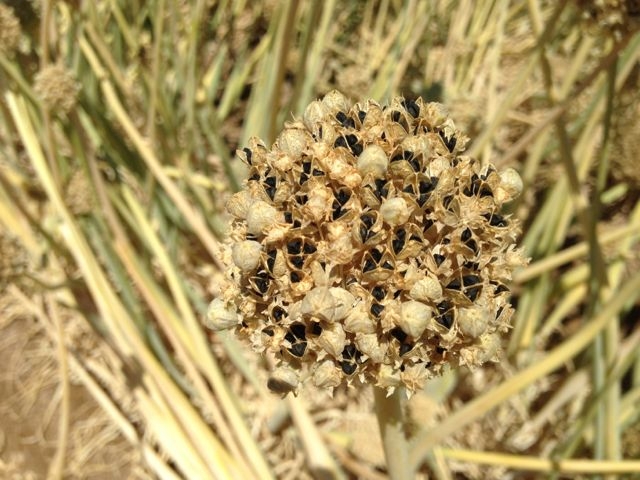
Onion umbel with seeds

